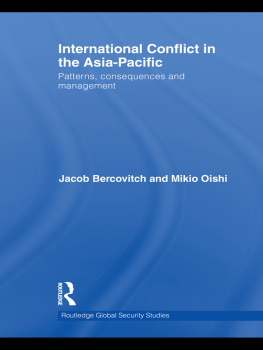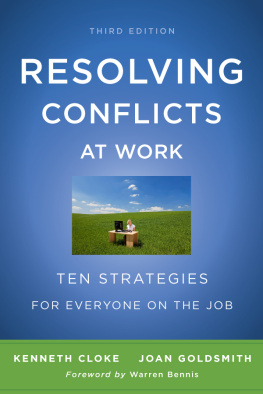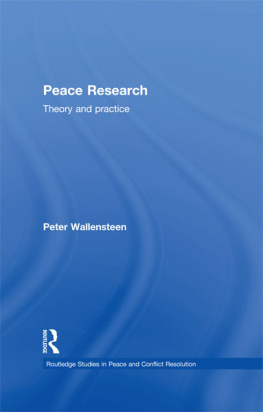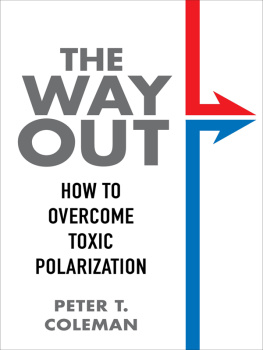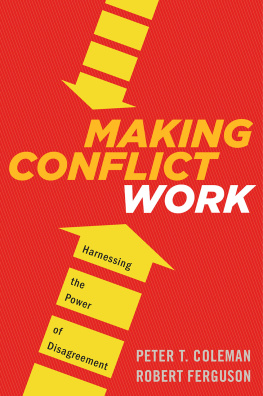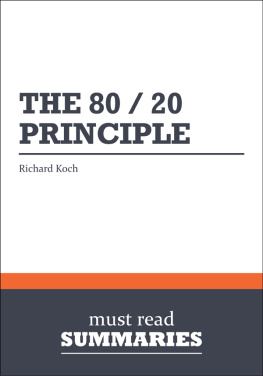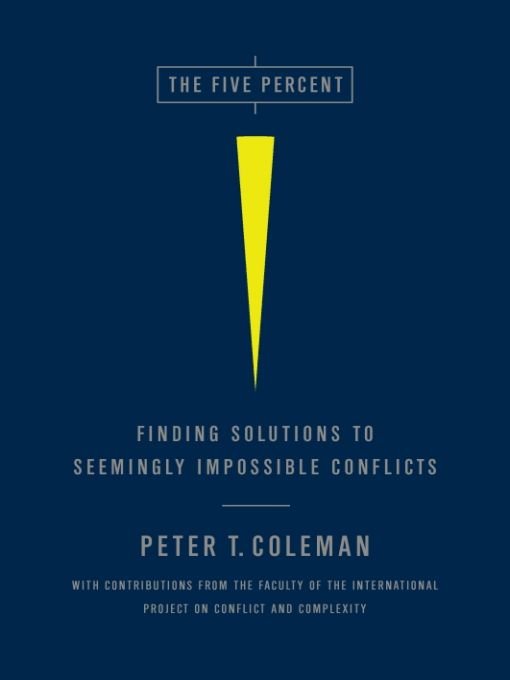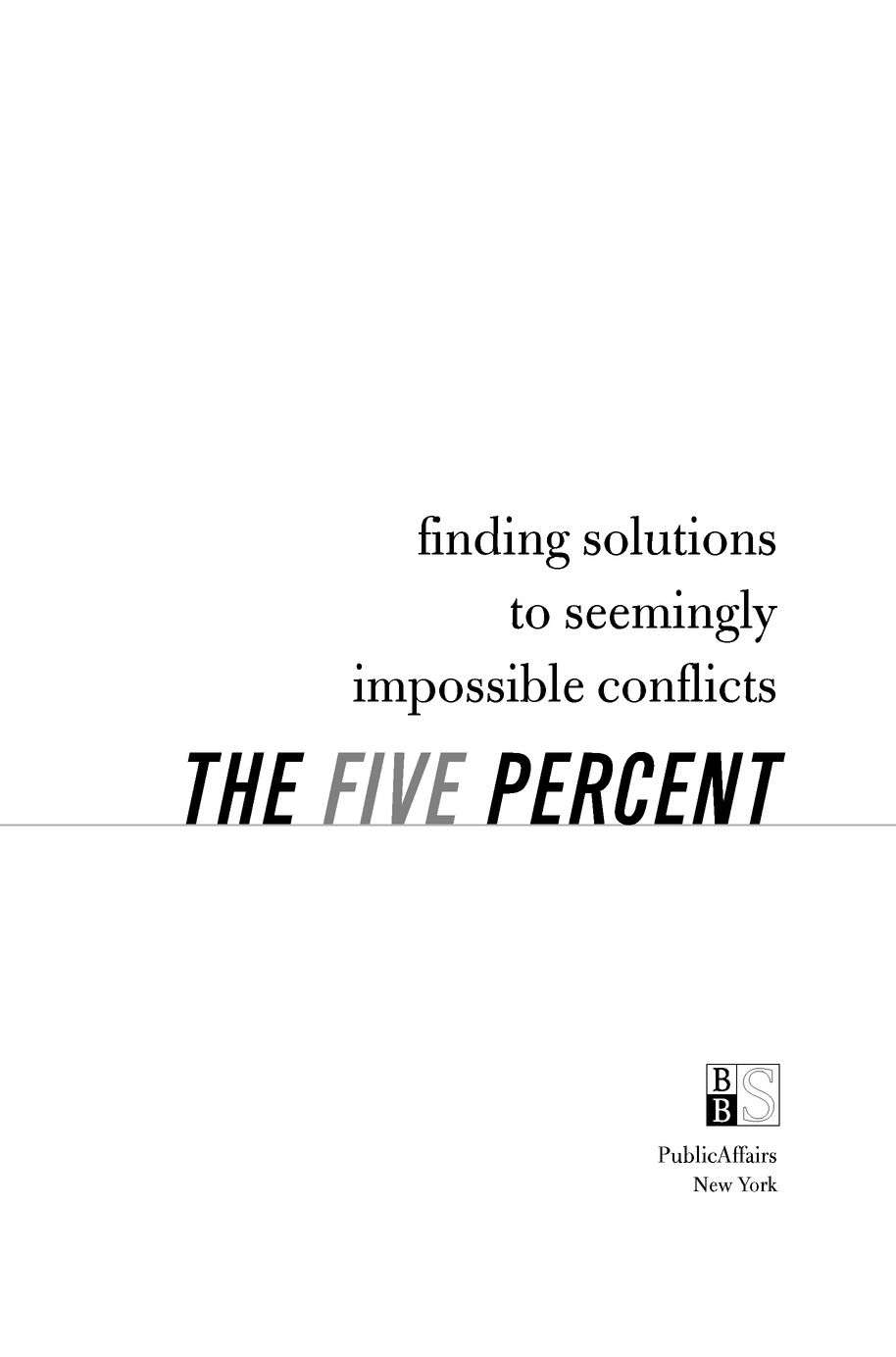Table of Contents
PETER T. COLEMAN, PhD
DIRECTOROF COLUMBIA UNIVERSITYSINTERNATIONALCENTERFORCOOPERATION ANDCONFLICT RESOLUTION
with major contributions from Robin Vallacher, PhD,
Andrzej Nowak, PhD, Lan Bui-Wrzosinska, PhD,
Andrea Bartoli, PhD, Larry Liebovitch, PhD,
Naira Musallam, PhD, and Katharina Kugler, PhD,
of the Project on Conflict and Complexity
For Mort Deutsch and Leah Doyle,
the coauthors of the best chapters of my life
acknowledgments
THIS BOOK BEGAN WITH THE SIMPLE QUESTION, Why are some conflicts impossible to solve and what can we do to resolve them? This is a question I have been working on with my colleagues and students at Columbia University for over fifteen years. The answer is both complex and simple. The research that went into answering this question has been very complex. It involved in-depth case studies of impossible conflicts, expert interviews, lab experiments, mathematical formalisms, computer simulations, and a thorough review of the scholarly literature. This led to an elaborate and nuanced understanding of these types of conflicts. But the ideas and methods for addressing these problems that came from this research, and from extensive interviews and conversations with conflict mediators and peacemakers of all stripes, are simple, basic, practical, and straightforward. These practices are the main focus of The Five Percent.
This book is the product of our team. We are a motley crew: an unlikely mix of social psychologists, an anthropologist, an astrophysicist, complexity scientists, conflict specialists, and peacemakers. We were brought together by a deep, shared commitment to addressing the misery and mystery of impossible, destructive conflicts. Our Dynamical Systems Team is composed of Robin Vallacher, Andrzej Nowak, Lan Bui-Wrzosinska, Andrea Bartoli, Larry Liebovitch, Naira Musallam, Katharina Kugler, and myself, Peter T. Coleman. Our work together is never easy, always fruitful, and has thus far been the highlight of my career.
But let me be clear: the insights shared in this book were born out of the confusion, conflict, and nonlinearity that come only from working with such a talented, opinionated, multidisciplinary team as ours. None of us could have accomplished this feat alone. Consequently, the ideas and methods outlined here often go against conventional wisdom in the field of conflict resolution. In fact, they tend to challenge it directly. This is part of our mad method: to create enough tension in our field to break through the current frames of understanding in order to begin a new conversation where we must all think different about the possibility of resolving impossible conflicts. Fortunately, our work has been generously supported by the visionary James S. McDonnell Foundation and the Community Foundation of Boulder. It has also been enlightened and supported by a host of extraordinary PhD students, including Christine Chung, Lukasz Jochemczyk, Wieslaw Bartkowski, and Ryszard Praszkier. We are greatly indebted to them all.
We also want to thank all the eminent scholars and practitioners whose work has served as a foundation and inspiration for ours. They include Mary Parker Follett, Kurt Lewin, Morton Deutsch, Dean Pruitt, Herb Kelman, Chris Mitchell, Ronald Fisher, Louis Kriesberg, John Paul Lederach, David Johnson, Dean Tjosvold, Bill Ury, Roger Fisher, Heidi and Guy Burgess, John Gottman, Philip Tetlock, Dietrick Dorner, Gareth Morgan, Laura Chasin, Bernard Pearce, Stephen Littlejohn, Paul Diehl, Gary Goertz, William Zartman, Jacob Bercovitch, and Stephen Cohen. Also, we wish to thank the incredibly supportive staff of our center, the International Center for Cooperation and Conflict Resolution at Teachers College, Columbia University, including Beth Fisher-Yoshida, Claudia Cohen, Molly Clark, Juliette De Wolfe, Jeff Schiffer, and Manpreet Sadhal.
Finally, I want to personally thank my family for their patience, care, support, and fun before, during, and after the writing of this book. My love, Leah, my children, Hannah and Adlai, and my infamous siblings, Bob, Cookie, Bob H., Michelle, and Patrick. They keep me happy, humble, and sane in an often seemingly intractable world.
introduction
THE IRRESISTIBLE POWER OF THEPAST
It began with a single act of hubris. Tantalus, the ruler of an ancient city in Greece and a favorite of the gods, decided one day to test the gods omniscience by chopping up and cooking his own son, Pelops, and serving him to them as a meal. Although the gods were on to this deceit from the beginning, one of them, Demeter, was distracted by her troubles with Hades. She feasted on the boys shoulder before realizing what was happening.
Furious with this deception, the gods banished Tantalus to the deepest part of the underworld, starved and tortured (tantalized) him for eternity, and cursed his entire family. So began the protracted misfortunes of the House of Atreus (Tantaluss descendants), which have served as the primary source of all tragedy from Homer and the great Greek dramatists to Shakespeare and ONeill.
Life went downhill in the House of Atreus after Tantalus. His daughter, Niobe, whose fourteen children were slain by the gods, was turned to stone. The gods brought Pelops back to life, but he ended up killing his father-in-law (who coveted his own daughter) in order to marry his bride. Pelops then had two sons, Atreus and Thyestes, who murdered their half-brother (the illegitimate son of Pelops) to please their mother. Later, Thyestes seduced Atreuss wife and stole his golden fleece before fleeing into exile. Believing himself forgiven, he later returned to enjoy a meal at his brothers table that turned out to be Thyestess own children.
Then things got complicated. Atreuss two sons Menelaus and Agamemnon married two sisters, Helen of Troy and Clytemnestra. Helens kidnapping started the Trojan War. Then, to appease the gods in order to set sail for war, Agamemnon sacrificed his own daughter, Iphigenia. He came home from the war ten years later only to be murdered by his wife, Clytemnestra, before she was dutifully executed in turn by her own son Orestes. He later was driven mad by the Furies who of course were obligated to punish matricide.
So it went in the House of Atreus for generation after generation. Tragedy begot unspeakable suffering and sparked more tragedy for all who followed: Iphigenia, Electra, Orestes, you name it. As this ancient legend goes, all of itthe murder, incest, cannibalism, betrayal, seduction, matricide, patricide, warsprang from the deeds of one man. His one act set in motion a chain of events that no human could stop. The curse of the House of Atreus was simply too powerful to resist. Time and again, the members of this misbegotten family, often against their own will and better judgment, were driven into evil by the irresistible power of the past.
SOME PROBLEMS NEVER GO AWAY.
Experts estimate that about 5 percent of our more difficult conflicts become intractable: highly destructive, never ending, and virtually impossible to solve. They occur in families, between friends, at work, among neighbors, and in the geopolitical arena. Like the gods curse on the House of Atreus, they seem to have a power of their own that is inexplicable and total, driving people and groups to act in ways that go against their best interests and that sow the seeds of their ruin.



